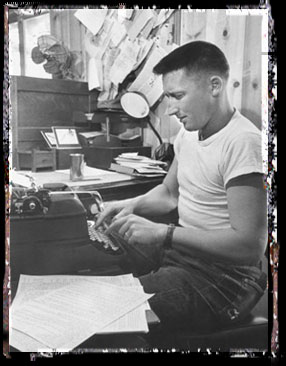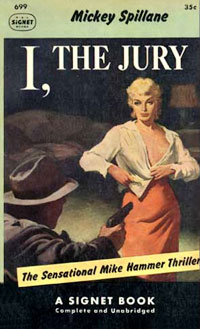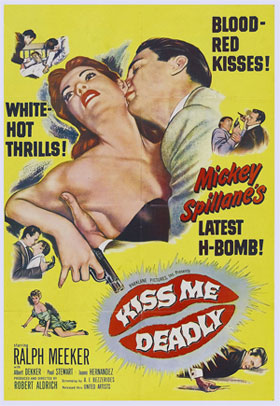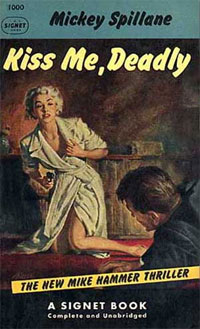A writer, pure and simple
(This obituary first appeared in The Star-Ledger of Newark, July 18, 2006)

The roar of the .45 shook the room. Charlotte staggered back a step. Her eyes were a symphony of incredulity, an unbelieving witness to truth. Slowly, she looked down at the ugly swelling in her naked belly where the bullet went in.
"How could you?" she gasped.
I had only a moment before talking to a corpse, but I got it in.
"It was easy," I said.
With that final paragraph from his first novel, 1947's "I, the Jury," Mickey Spillane made his bones.
Spillane's books - with their then-startling mix of sex, sadism and gunplay - redefined the detective story for the post-World War II generation, and made him one of the top-selling American authors of all time. Most of his more than two dozen novels featured his harder-than-hard-boiled detective Mike Hammer, who battled, gangsters, goons and Communists with equal ferocity, often aided by his adoring secretary, Velda.
Spillane, 88, died yesterday at home in Murrells Inlet, S.C., a small coastal community where he'd lived since the 1950s. The cause of death was not immediately known.
"I'm not an author, I'm a writer, that's all I am," Spillane said in a 2001 interview. "Authors want their names down in history; I want to keep the smoke coming out of the chimney."
He was born Frank Spillane in Brooklyn on March 9, 1918, and baptized with the middle name Michael, which his father shortened to Mickey. An only child, he spent his formative years in Elizabeth, N.J., growing up in the Bayway section of the city and attending Theodore Roosevelt Junior High School, reunions of which he regularly attended through the years.
In 1989, a block on South Broad Street, between Bayway Avenue and Myrtle Street, was renamed "Mickey Spillane Way." Spillane had mixed feelings about the honor.
"I don't believe in that kind of self-adulation," he told the Star-Ledger at the time. "Streets should be named after birds or numbers or something."
Spillane's family eventually moved back to Brooklyn, where he graduated from Erasmus Hall High School in 1935. He sold his first story to Liberty magazine that same year and eventually became a comic book writer, creating the character Mike Danger. In the mid-1940s, when wartime production curtailed comic books, Spillane switched back to prose.
Spillane enlisted in the Army Air Corps and, on returning home, decided to write a novel to try to raise enough money to buy some property.
 "I, the Jury" - the story of Hammer seeking revenge for a war buddy's murder - was originally published in hardcover by E.P. Dutton, but found its audience a year later through the then-new medium of paperback.
"I, the Jury" - the story of Hammer seeking revenge for a war buddy's murder - was originally published in hardcover by E.P. Dutton, but found its audience a year later through the then-new medium of paperback.
Despite uniformly savage reviews (one critic suggested the book be "required reading in a Gestapo training school"), "I, the Jury" sold nearly a quarter of a million copies in its initial softcover run. More Hammer books followed, all in inexpensive mass-market paperbacks, often graced with lurid covers featuring women in various states of undress.
Spillane's books featured slam-bang beginnings - usually with some innocent being killed in the opening pages, leaving Hammer to avenge their deaths. "The first line sells that book," Spillane once said. "And the last line sells the next."
Titles sell books too, Spillane knew, and he chose them with equal care and an emphasis on pronouns - "My Gun is Quick," "Vengeance is Mine!," "Kiss Me, Deadly." Shock value was as much a part of the Spillane appeal as the breathless plots and tough-as-nails attitude. In his books, Spillane torqued up the sex and violence to a pitch that was previously unseen in popular fiction (in 1947, the debut of Ian Fleming's James Bond was still six years away).
Though his books seemed sometimes misogynist - or even downright misanthropic - Spillane's rough-hewn, often graceless prose sometimes achieved a primitive power akin to Beat poetry. And America loved it. By industry estimates, his 26 books have to date sold more than 200 million copies.
"Hemingway hated me," Spillane said in a 2001 interview. "I sold 200 million books, and he didn't. Of course most of mine sold for 25 cents, but still ... Those big-shot writers could never dig the fact that there are more salted peanuts consumed than caviar."
Spillane's influence went "beyond the printed page," according to novelist and film noir expert Eddie Muller, who knew Spillane. "He almost single-handedly created the market for 'pocket books' in the late 1940s, and he was one of the first authors media-savvy enough to promote himself as a character.
"I don't particularly love his novels, but it was impossible not to love the guy," said Muller. "He was, arguably, the bestselling fiction author of the last century, and yet he never took himself seriously. That's class - which Mick would have hated being accused of having."
With his Hammer books, Spillane retooled the Dashiell Hammett/Raymond Chandler tradition for the post-WWII era and an audience that had already seen its share of killing. Unlike Sam Spade and Philip Marlowe, Hammer let his gun do the talking more often than not. For some, Spillane's hero represented the disaffected American vet, the battle-hardened realist who came home to a country riddled by corruption and newly populated with empowered women. A Pacific veteran, Hammer carried a Colt .45 automatic, the ubiquitous WWII servicemen's weapon. Spillane himself owned the same gun - and had a permit to carry it - for most of his life.
 Hammer made the leap to movies almost immediately, with a 1953 adaptation of "I, the Jury." Other films followed, the most notable being Robert Aldrich's nightmarish 1955 "Kiss Me, Deadly," which starred Ralph Meeker as a thuggish Hammer pursuing a "Great Whatsis" that turns out to be a case of radioactive isotopes. At the end of the film, which became a major influence on the French New Wave, Hammer is left gutshot and radioactive, floundering in the L.A. surf. Spillane himself played Hammer in 1963's "The Girl Hunters," opposite Shirley Eaton.
Hammer made the leap to movies almost immediately, with a 1953 adaptation of "I, the Jury." Other films followed, the most notable being Robert Aldrich's nightmarish 1955 "Kiss Me, Deadly," which starred Ralph Meeker as a thuggish Hammer pursuing a "Great Whatsis" that turns out to be a case of radioactive isotopes. At the end of the film, which became a major influence on the French New Wave, Hammer is left gutshot and radioactive, floundering in the L.A. surf. Spillane himself played Hammer in 1963's "The Girl Hunters," opposite Shirley Eaton.
"I don't like any of them," he said of the film adaptations. "Because (the filmmakers) don't read the books. In 'Kiss Me, Deadly' my story is better than (the movie) story ..... They (change it) because it's Hollywood. Everybody wants their name on the screen."
Despite the sex and violence that became his literary trademark, Spillane had been a devout Jehovah's Witness since the 1950s. He was married three times and fathered four children.
And though most of his novels were set in Manhattan, Spillane had lived in Murrels Inlet since 1953, when he moved there from Newburgh, N.Y. "It agrees with you," he said in a 2001 interview. "I'm a country boy. I hate New York. But that's where things happen, so I use it as a base for stories."
 Among his more unlikely fans, Spillane numbered writer and philosopher Ayn Rand, author of "Atlas Shrugged" and "The Fountainhead," and with whom he corresponded. She praised Spillane's writing style in her book "The Romantic Manifesto." "There is not a single emotional word or adjective in Spillane's description," she wrote. "He presents nothing save visual facts; but he selects only those facts, only those eloquent details, which convey the visual reality of the scene and create a mood of desolate loneliness."
Among his more unlikely fans, Spillane numbered writer and philosopher Ayn Rand, author of "Atlas Shrugged" and "The Fountainhead," and with whom he corresponded. She praised Spillane's writing style in her book "The Romantic Manifesto." "There is not a single emotional word or adjective in Spillane's description," she wrote. "He presents nothing save visual facts; but he selects only those facts, only those eloquent details, which convey the visual reality of the scene and create a mood of desolate loneliness."
In the late 1970s and '80s, Spillane took an extended vacation from writing, though Mike Hammer lived on, in a long-running television series starring Stacy Keach. Spillane himself stayed visible playing himself in a series of Miller Lite ("She poured. We drank. To be continued") commercials.
The literary Hammer returned in 1987's "The Killing Man," Spillane's first novel in 16 years. "I used to write fast, but I can't now, my rear end gets tired," he said. "I can't put in 12 hours a day sitting in a chair."
Two more novels followed, the last being 2003's "Something's Down There." In 1995, the Mystery Writers of America honored him with a Grand Master award.
"If the public likes you, you're good," he once said. "I don't give a hoot about reading reviews. What I want to read are the royalty checks."
For Mickey Spillane, becoming the most successful pop novelist of his day wasn't a knock-down, drag-out brawl. It was easy.
